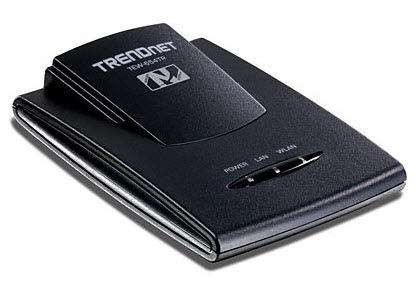Wireless Networking: Nine 802.11n Routers Rounded Up
TRENDnet TEW-654TR And TEW-671BR
We wanted to throw in at least one wild card in this roundup. TRENDnet’s TEW-654TR ($58.89) is a travel router measuring just 2.4 x 3.2 x 0.7 inches. The pocket-sized marvel weighs just 1.6 ounces. It features two internal 2.4 GHz antennas and is rated to cover about a 160-foot radius under indoor conditions—plenty big to cover the hotel rooms it’s meant for unless you’re hob-nobbing at the top of the Venetian.
The idea is that instead of being stuck at a tiny desk with an uncomfortable chair, you plug the router into the room’s Ethernet feed and kick back in your bed with either your laptop’s built-in Wi-Fi or the TEW-624UB dongle TRENDnet throws in with the kit. Of course, if you’ve got several people in the room with you (presumably not in the bed), they can hop on the wireless connection with their own clients.
Be aware that there are no LAN ports on this unit. You get one WAN port and the rest is wireless. Apart from Wi-Fi Multimedia QoS, WPS setup, and the ability to flip the router into an access point mode, there’s not really much else here to discuss. OK, the carrying case is nice, too. And no, the performance we witness was nothing to write home about. This is meant to be a business solution, not a gaming product, and we viewed it as such. All things considered, we thought the little TEW-654TR put in a respectable showing.
We’d hoped to review the TEW-673GRU, TRENDnet’s latest router. The company was kind enough to send us a pre-release model a couple of months ago, but we were unable to get satisfactory results from it. By no small coincidence, the 673GRU still has yet to release as of this writing. Instead, we tested the TEW-671BR ($83.80) TRENDnet had already sent us. We were intrigued to see how this unit fared because, while it’s a simultaneous dual-band model, it only features two 2 dBi external antennas rather than the usual three. However, there are another two 4 dBi internal antennas. For SDB, $84 is a screaming deal—if the router actually performs.
Admittedly, the SDB functionality is sort of the whole TEW-671BR story. The four LAN ports are 10/100. You get the usual base-level QoS features, integrated security, and WPS. Tack on TRENDnet’s three-year warranty and this emerges as a strong budget offering.
Get Tom's Hardware's best news and in-depth reviews, straight to your inbox.


